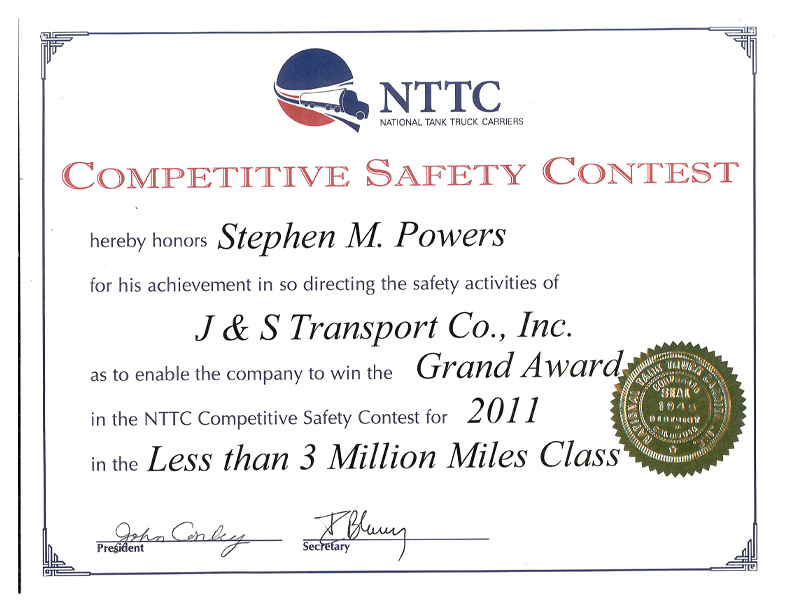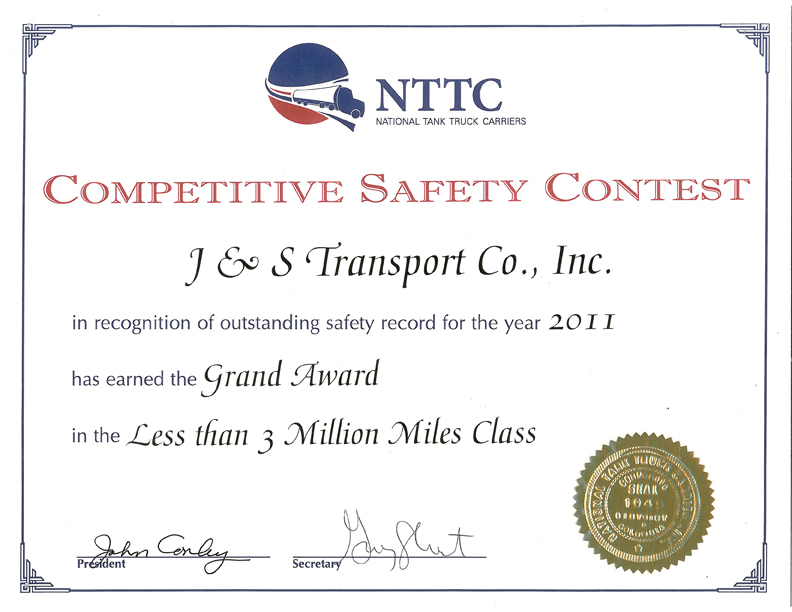Fuel Transportation Quandary
Boston Hazardous Material Routing
“Catch-22”
Position Paper
October 8, 2008
Docket No. FMCSA-2008-0204
Written by: John Hamel, President, J&S Transport Co., Inc
12 R Washington Street
Lynn, MA 01904
prelude
For years it has been perplexing for fuel transporters to safely and legally navigate the roads in and around the City of Boston, Massachusetts. This bewilderment is attributed to many factors including the roadways constantly changing because of years of endless construction i.e. The Big Dig Central Artery Tunnel Project. However, to complicate and compound the issue, the Boston hazardous material transportation rules and routes to pass through the City of Boston are complex.
The complexity of interpreting the transportation rules is due primarily to the conflicting rules and positions established and maintained by the Federal Government 49 CFR 397, State Government – The Massachusetts Department of Highways (MassHighway), local enforcement (Boston City Police) and the Mass Turnpike Authority on what proper permitting is required and what route should be driven to meet the guidelines established to safely get in and around the City to make deliveries. The later providing the most confusion and pain.
When considering the transportation of hazardous materials, unequivocally the issue of safety requires first consideration, in particular when establishing a hazardous material route through a major City like Boston. The question then becomes what other factors are also considered i.e. How is this safety route established? Who is involved? What is the process for approval? Who makes the final decision? Lastly, how is the transportation route regulation communicated to the commercial companies and drivers?
Due diligence is a necessity by the regulatory agencies when considering a hazardous cargo transportation route to assure all interested parties have a say in the final decision. In the case of transporting hazardous material through the City of Boston it is the City of Boston that has to perform due diligence to assure that all parties have had an opportunity to express their issues and concerns? It is realized and obvious that even if all parties are invited to express their concerns not all will be in agreement to the final solution. Ah, democracy!
The intent of this paper is to provide and enlighten hauling companies and individuals responsible for transportation of hazardous material (fuel) on the various intricacies on hauling fuel in and around the City of Boston. The paper is also designed to spark questions on the regulation process and their practices, the person or persons making the final decisions, how those final decisions are communicated to the public and more importantly the transporters and their drivers to assure they understand the proper transporting route and are adhering strictly to all the regulations.
It is not the intent of this paper to criticize any particular state or federal office. Their job is complex and it is clearly understood that their decisions, with respect to routing hazardous material transporters, are difficult.
This paper may include some inaccurate information contingent upon opinion, source or timing. The reader should confirm any and all information provided in this paper.
Synopsis
J&S Transport based in Lynn, Massachusetts, and founded in 1992 by John and Sharon Hamel, provides fuel transport delivery services for many companies that include both major oil companies as well as many independent service stations. The company has been transporting fuel in and around the City of Boston, Massachusetts since its founding. Prior to J&S John had been delivering fuel in and around Boston since 1982.
Over the years the City of Boston had virtually no enforcement of said Hazmat Route.
From I-93South all Hazmat vehicles exited at High Street which today no longer exists. The only posting for a designated route was at that exit, once off the interstate the drivers were not directed along a posted route. Unless a driver was familiar with the city streets he was on his own. I have personally delivered to or driven through the city countless times and not once had an incident, or been aware of any serious incident. At times the Boston Fire Department would be located at the bottom of the High Street exit only checking to see if vehicles were loaded during the curfew hours 7-9AM and 4-6PM. If a vehicle was empty or had #2 fuel, or diesel fuel on board he was allowed to proceed. Not once was I asked to see a copy of a permit.
Over the last few years the difficulty of navigating in and around Boston has steadily increased. The Boston City Police Special Operations Unit had been assigned to stop hazardous material carriers and determine if their deliveries are for directly inside the City limits. If the transporter/driver could not provide the appropriate paperwork showing that they were making a delivery in Boston they were given a fine of $500-$1,000. Up until 2006 the City of Boston would allow through traffic to areas just south of the city.
Today the permitting process has become very lengthy and time consuming, once issued a permit it is only good for deliveries within the city limits except during curfew hours when no vehicles are allowed regardless of whether they are empty, loaded or type of product on board. The permit is needed between the hours of 6AM and 8PM Monday thru Friday weekends and Holidays are excluded.
Unfortunately the Boston Police Special Operations Unit has been directed to stop and ticket all HazMat vehicles regardless of time of day or day of week. The citations, at least all citations written to J&S or J&S drivers, have been for violation of Federal Code 397.67(b) which states that vehicles shall operate over routes that do not go through or near heavily populated areas, places where crowds are assembled, tunnels, narrow streets, or alleys, except where the motor carrier determines that: (b) (1) There is no practical alternative.
The problem I find with that is 397.67(b) states that a motor carrier carrying hazardous materials required to be placarded in accordance with 49CFR 177.823 and not subject to NRHM routing designations shall operate over routes that do not go through or near heavily populated areas, places where crowds are assembled, tunnels, narrow streets, or alleys, except where the motor carrier determines that: (b) (1) There is no practical alternative. We are subject to NRHM routing designations filed by the Mass Highway Department.
J&S has taken the issue to court on appeal and was found not responsible for five tickets issued to both the company and drivers.
The question now becomes why the Boston City Police Special Operations Unit continues to issue fines when clearly they are not in accordance with the established regulations?
The first reason of course is safety, although one must ask is it safer to travel the 4 miles through Boston or is it safer to travel 56 miles around the city taking you through many other cities and towns creating added exposure and risk and possible driver fatigue. Or could it be Boston just does not want any trucks traveling through the city.
Boston has argued that the route has not changed over the years when it clearly has, the only similarity between the old and new routes is the last mile from Congress Street and the Surface Road to the point where it rejoins I-93. The permitting process has also changed, the documents required to be submitted, the time between submitting an application and receiving a permit, the refusal to issue through traffic permits and not following their stated permitting times 6AM thru 8PM.
Conclusion
In Boston there is a clearly marked route for fuel tankers to travel safely through the City. For years hazardous material carriers have been utilizing the designated route, even when the route is detoured during construction, without any major incident.
The cost of trucking around the City is exorbitant and with rising fuel costs, increased labor costs, reduced productivity and so many other issues arising from Boston’s refusal in my opinion to follow the required process and procedures before enforcing a HazMat Ban is forcing trucking firms to reconsider their position in the market place. This could result in business failure leading to additional unemployment which the state can ill afford, an increase in the cost of gasoline and fuel to the citizens of the affected cities and towns to the south of the city. The transportation costs will eventually have to reflect the true mileage to those communities, and finally the possibility of outages to those communities.
Multiple people who are affected by not allowing fuel transport to travel through the City have not been consulted i.e. trucking companies, businesses, the general public and surrounding towns to include elected officials, first responders and other emergency personnel.
The federal government and MassHighway have made every effort to correct this issue and will need additional support going forward to make access for shipping hazardous material through the City a reality.
J&S Transport will continue to challenge the City of Boston hazardous material trucking route until a consistent and amicable option is provided. J&S Transport will also continue to assist other hazardous material transporters and trucking associations to continue to clarify options available to the industry.
Questions are welcome by contacting:
John Hamel – President
J&S Transport



